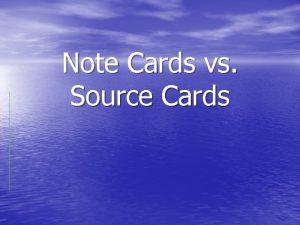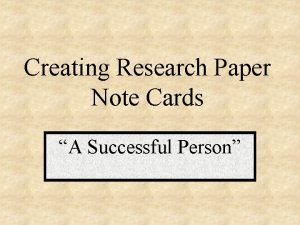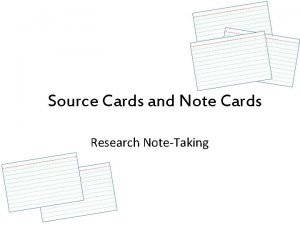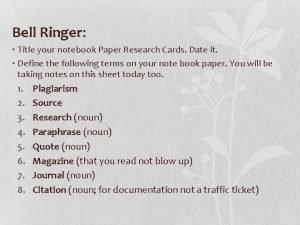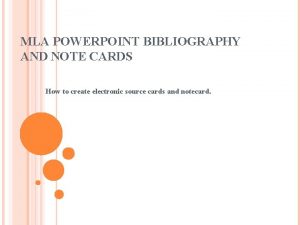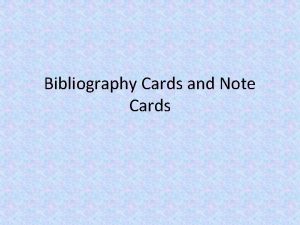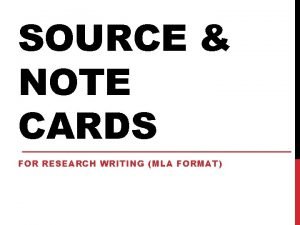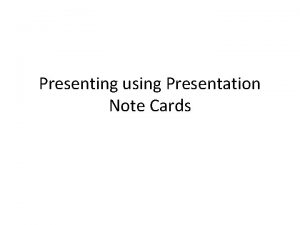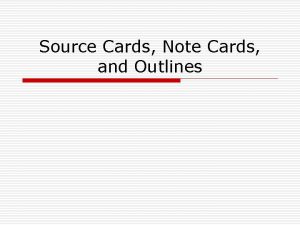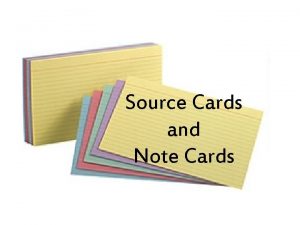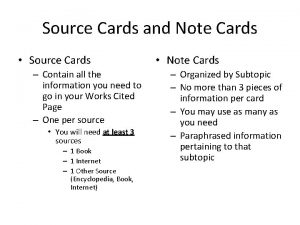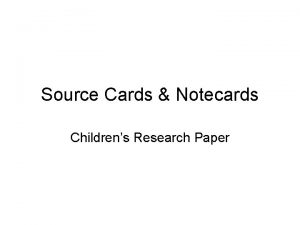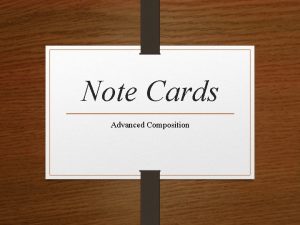The Research Process Source Cards Note Cards FACTS












- Slides: 12

The Research Process Source Cards & Note Cards

FACTS: • You must have a source card for every source that you find. • Note cards are only for information that you consider useful. This is the information that you MIGHT put in your paper. • You should always have more Source cards than sources and more Note cards than you need!

Source Card PAGE 37 OF STYLE GUIDE Author or Editor of book Roman numeral to number all source cards – Alphabetically by author. (for a book) Smith, Joe. How to Write a Research Paper. New York: Holt Publishing, 2000. Date of publication Title of book IV Place of publication Publisher

Source Card (for an Internet site) Author or editor Title of site Roman numeral to number all source cards – Alphabetically by author. VI Peterson, Joan. The Respectful Student. 2007. (9 Mar. 2001). Date of access Date of Publication

Source Card (for a Database) Title of article Author or editor Belanger, Jennifer. "Teenagers and Society. " Postmodern Culture (1990). Gale Online (30 March 2001). Name of Database Date of access Date of publication Name of magazine or journal

Note. Card (for a any source) Source info & page # Title Heading Writing a research paper Smith, 27 Quotation, paraphrase, or summary of information found from source. IV - 3 Actual information. Source #, Card #

In-Text Citations - In-text citations are used to show the reader the source that you got your information from. - It is also a way to give credit to the author from whom you got the work from. There are two types of notes you will take: Direct Quote- Information taken from a source exactly as it was written. Paraphrased Note- Information from a book, etc. put into your own words.

In-Text Citation for a BOOK, INTERNET SITE or DATABASE (with an author or an editor) (Smith 34) Author’s last name Page number(s) where the information was found

In-Text Citation for a WEBSITE, or DATABASE (without an author or an editor) (“Media”) First word of the title in quotes **If you have two titles with the same first word use the second word in the title as well. **If you have a title that starts with “the” or “a”, use the word that comes after it as well.

EXAMPLE OF A SENTENCE THAT IS CITED: DIRECT QUOTE - "The percentage of children that play video games is eighty-five percent" (Smith 98). PARAPHRASED - Aliens were sited in Roswell, New Mexico during the 1980's (“Roswell”).

Some other tips… When using more than one author: Citations (Smith and Jones 84) (Smith, Jones, and Watts 31) Works Cited – Smith, Joan and Jim Jones, Monica Watts. Using an editor: Smith, Joan ed. (put the “ed. ” abbreviation for editor after their name)

The Works Cited page (MLA Format) ü Gives credit to the author(s) or editor(s) of the books, Internet or database sites that you used for your research. üAll entries in the Works Cited page must correspond to the works cited in your paper and vice versa.
 What are source cards
What are source cards Source cards for research paper
Source cards for research paper Quotation note card
Quotation note card Mla note cards
Mla note cards Which information goes on a source card?
Which information goes on a source card? Source cards for research paper
Source cards for research paper Bibliography note cards
Bibliography note cards Bibliography card
Bibliography card Note cards mla format
Note cards mla format Mla note cards
Mla note cards Cue cards for speech
Cue cards for speech Difference between note making and note taking
Difference between note making and note taking Note making and note taking difference
Note making and note taking difference
